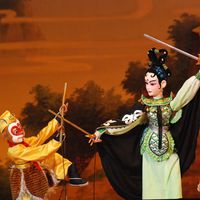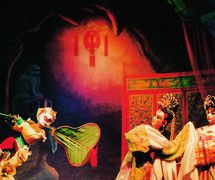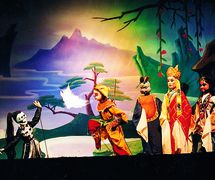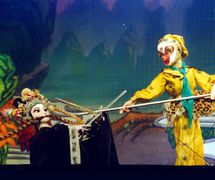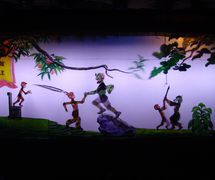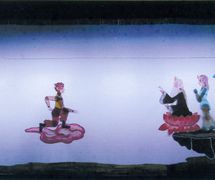Mythical figure from Chinese literature, opera, puppet theatre and shadow plays. The Monkey King existed in popular literature before the novel Journey to the West (Xiyou ji) was written by Wu Chengen in 1550, but this classic work of Chinese literature serves as the reference for the mythical journey of a small group that seeks the Buddhist sutras in the “West” (here, India). Two repentant coarse creatures (“Pigsy”, Zhu Baijie and “Sandy”, Sha Wujing), and Monkey King are the companions who assist the master Xuan Zang (Buddhist monk, Tripitaka) through perilous terrains in this great epic.
Also called Sun Wukong (Monkey Awakened to Emptiness), Monkey first seeks immortality studying with a Taoist (Daoist) master (Subodhi) who initiates him. But the now arrogant Monkey assumes the name “Great Sage Equal to Heaven”, since he is seemingly invincible with multiple supernatural powers and his magic staff, which can grow as large as he needs. He fights with the Jade Emperor, creates havoc in heaven and eats the peaches of immortality. But he finally has to submit to the Buddha, who imprisons him for 500 years under Five Element Mountain. Eventually, Sun Wukong is freed by the compassion of the bodhisattva Guanyin, but in exchange he must escort Tripitaka on his mission. Boastful, clumsy, but also loyal, brave and cunning, the Monkey King with his magic staff triumphs over all the demons and surmounts all obstacles on their journey. He is at once playful and crafty, but he also mocks and rebels against the establishment and is such a model of independence and bravery that he was praised by Mao Zedong as an exemplar of the virtues of the Chinese.
Monkey is comparable to Hanuman in the Indian epic Ramayana. Monkey King has a monkey-like face and appears in the role of a “painted face” (jing) character in Jingju (Beijing/Peking Opera). He is also a popular character of the rod puppet, glove puppet, string puppet and shadow theatres. The many episodes of the story furnish inexhaustible source material for traditional and modern versions of the story. Today, one finds the figure used on television, in cinema, advertisements, animations, and numerous derivatives, candies and toys. Monkey is a reflection of the contradictory tendencies in human nature, governed by hungers and passions, but also striving for enlightenment and seeking self-perfection.
(See China.)
Bibliography
- Humphrey, Jo. Monkey King: A Celestial Heritage. An Introduction to Chinese Culture Through the Performing Arts. New York: Chun-cheng Art Gallery, 1980.
- Wu, Cheng’en. La Pérégrination vers l’Ouest (Xiyou ji) [Journey to the West]. Paris: Gallimard, 1991.









